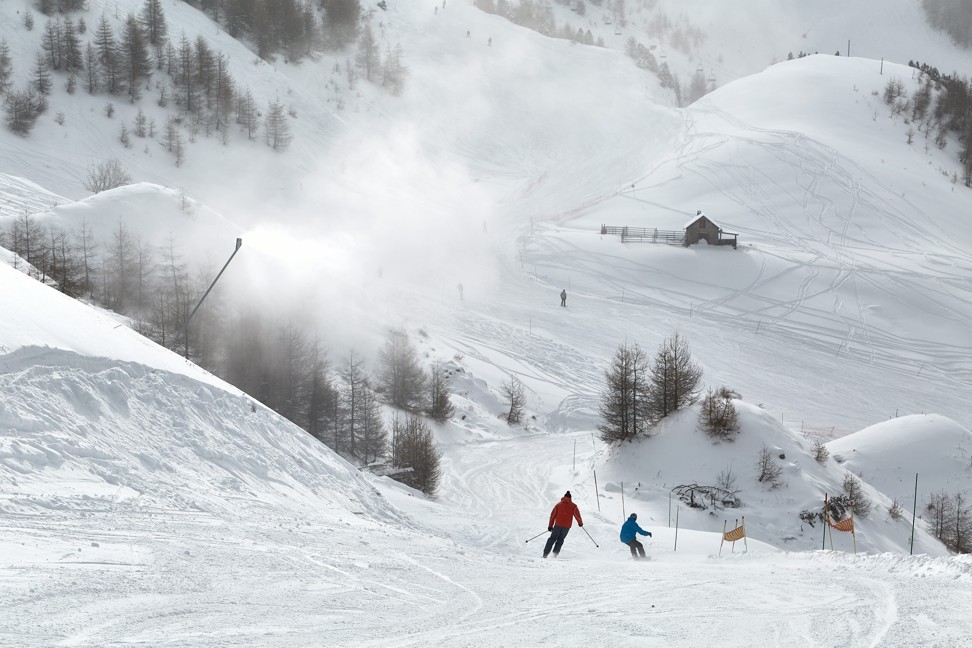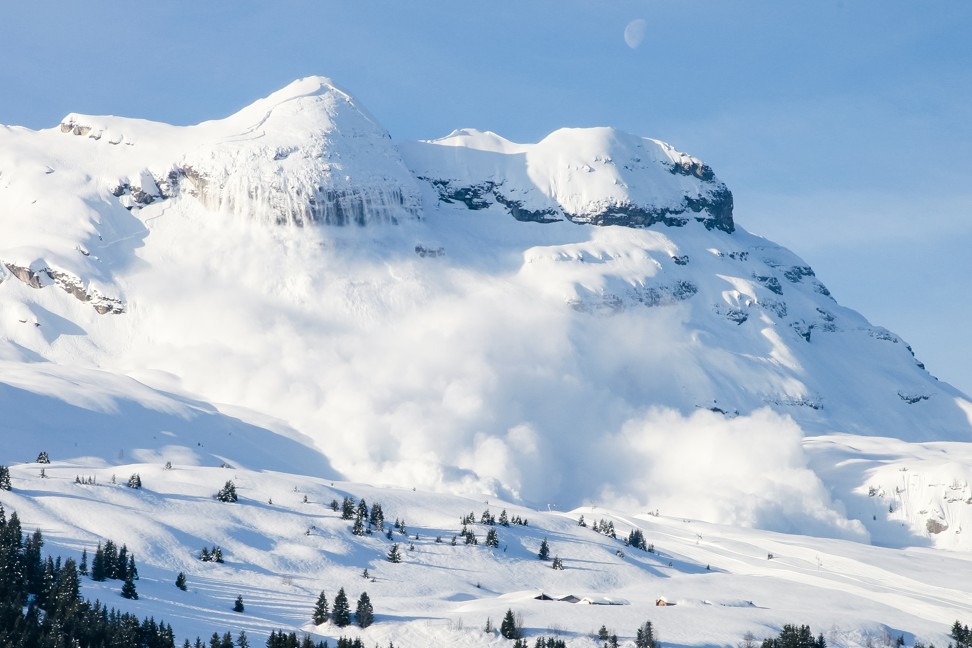
Skiing in the French Alps: the good, bad and ugly sides to a destination that was once the realm of the rich
- These days, the slopes offer something for everyone – from dog sledding to star gazing – to try and attract a younger clientele
- With under-25s representing only 14 per cent of skiers in France, the efforts are obviously not enough
The good
When it comes to skiing superlatives, the French Alps take some beating. La Plagne is the world’s most visited resort while Chamonix is home to both the world’s steepest ski run and the Aiguille du Midi cable car, which holds the record for the highest vertical ascent. Les Trois Vallées (The Three Valleys) is a group of interlinked resorts that make up the world’s largest alpine ski area, with 600km of slopes, 169 lifts and 3,000 instructors. And, after building up un énorme appétit, fill up on fish and chips at the Frog and Roastbeef, the highest pub in Europe, which, appropriately enough, is in Europe’s highest ski resort, Val Thorens.
Being the biggest and the best isn’t everything, of course, but it does mean the French Alps offer something for everyone, from rubber-legged beginners to off-piste pros. It’s not all about tearing down the mountain at breakneck speed, however. Destinations such as La Plagne are diversifying and now offer alternatives for non-skiers, including dog sledding, star gazing and tobogganing trips. There is also plenty of choice when it comes to après ski activities: Val d’Isère, Alpe d’Huez and Morzine are a good bet for after-dark distractions, with a wide variety of bars – many with live bands and resident DJs – nightclubs, outdoor ice rinks, snow parties and festivals.
Skiing has long been associated with health, wealth and glamour (ski scenes have featured in no fewer than seven James Bond films) and, like Hong Kong, the higher up the peak you go, the more exclusive things become. Courchevel boasts more Michelin-starred restaurants than any other ski resort in the world, lofty Val Thorens epitomises Alpine chic and the prices are as steep as the pistes in Méribel.

Generally speaking, high-altitude resorts stand the best chance of regular snowfall, which adds to their cachet – who doesn’t enjoy carving through freshly fallen powder surrounded by stunning scenery? But a skiing holiday no longer means having to take out a second mortgage to keep up with the glitterati. Budget airlines and property-sharing platforms, such as Airbnb, have made it easier to piece together competitively priced DIY packages.
Technology has changed the skiing experience significantly in recent years. Snow reports, weather forecasts, road conditions and accommodation availability are all a mouse click away. Advances in skis, boots, bindings and helmets have improved safety while cutting-edge snow-making systems ensure optimal conditions throughout the season and beyond.
The French Alps are enjoying a surge of popularity with a new clientele; winter-sports enthusiasts from countries as diverse as Russia, Turkey, Israel, Brazil and China are mastering moguls and snowplough turns. Visitors from established markets haven’t gone away, though. In fact, many veterans are now able to take advantage of free ski passes (over 75s pay nothing in Val Thorens, Courchevel, Méribel, Val d’Isere and Tignes, among others).
The bad

Offering free lift passes to loyal silver skiers is probably not the best way to attract a new generation onto the slopes, but the French ski industry is traditional (some accommodation retains a level of service that has been described as “based on the standards of the 1970s”). Nor are all resorts user-friendly. Visitors may need to park in one place, organise ski rental in another, purchase lift tickets at a third location and then traipse around trying to arrange a lesson.
Despite the efforts of places such as La Plagne to offer a diversified range of activities, some resorts have been slow to recognise the need to attract a younger clientele keen to combine skiing with zip lining, spa treatments, indoor water parks and, perhaps, a tour of the local cheese cooperative. In fact, skiing is at risk of being shunned entirely by those who regard the sport as an overpriced activity loved by their parents (and grandparents). According to a survey by the National Association of Mayors of Mountain Resorts, under-25s represent only 14 per cent of skiers in France – the figure was 20 per cent in 1995.
The perception of skiing as a status symbol has also diminished, partly due to all those budget flights. It’s true that James Bond regularly takes to the slopes – the only thing is, it’s rarely in the French Alps. Filming is more likely to take place in Switzerland, Italy or Iceland.

There’s usually a much better chance of snow at higher resorts, so the white fluffy stuff that blankets Val Thorens may well be falling as drizzle further down the mountain. Climate breakdown is blamed for the increasingly erratic snowfall – from 1960 to 2017, the winter season shortened by 38 days and according to some reports, as many as 200 ski stations now stand abandoned across the Alps. Two-thirds of French resorts rely on snow machines, whose collective energy consumption worsens the environmental problems they are supposed to be solving, including the depletion of water reserves. Nevertheless, studies suggest that the only way to maintain France’s ski industry is to continue investing in artificial systems; make snow or the visitors will stop coming.
Unfortunately, too many of them are going to Mont Blanc (4,800 metres), and indulging in all sorts of shenanigans on Western Europe’s highest mountain. This week, in an attempt to protect Mont Blanc’s biodiversity, French President Emmanuel Macron announced the establishment of a protected zone around the mountain and a limit to the number of people who can access the summit.
The swanky high-altitude resorts offer the best chance of snow, and can afford to buy the most advanced snow-making equipment in case none falls, but they are also prone to winds strong enough to cause chairlift and cable-car closures. It is often bitterly cold and the frigid temperatures, combined with an absence of snow, can result in pistes that become as hard as concrete, and thus treacherous, as fresh flurries are quickly blown away.
On the subject of strong winds, skiing isn’t the only adrenaline rush on offer at Courchevel. The local airport has been described as Europe’s most dangerous, due to its complicated approach, short runway and frequently hazardous weather conditions. The so-called altiport is suitable only for turboprop planes (commercial aircraft and private jets aren’t allowed in for safety reasons), and fewer than 100 pilots are qualified to land on Europe’s highest tarmacked runway. Flights are eye-wateringly expensive, but people staying at a resort where a plate of pasta costs €40 (HK$340) probably don’t mind too much.
The ugly

Avalanches are usually caused by fresh heavy snowfall that fails to bind with existing, hard-packed snow. Between 500 and 1,500 avalanches are recorded in the French Alps each year, resulting in dozens of deaths.

